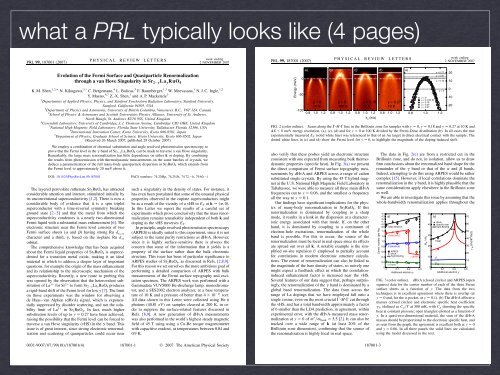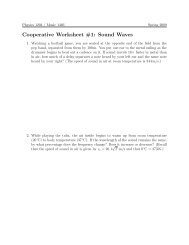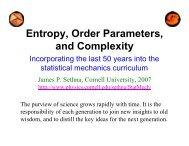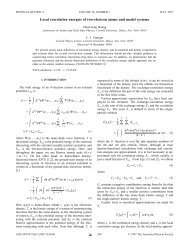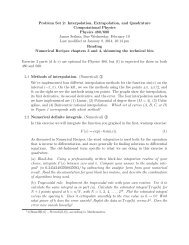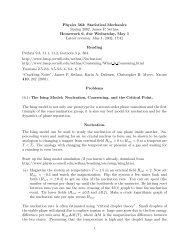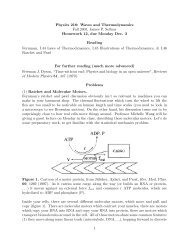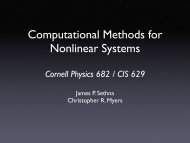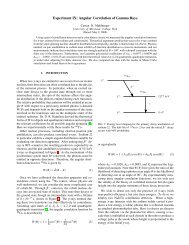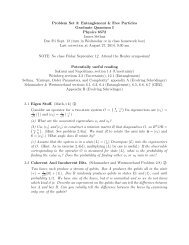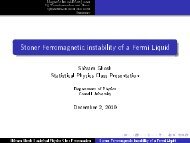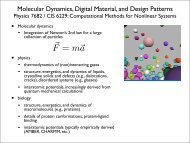writing lab reports - Are you sure you want to look at this?
writing lab reports - Are you sure you want to look at this?
writing lab reports - Are you sure you want to look at this?
- No tags were found...
Create successful ePaper yourself
Turn your PDF publications into a flip-book with our unique Google optimized e-Paper software.
wh<strong>at</strong> a PRL typically <strong>look</strong>s like (4 pages)PRL 99, 187001 (2007)PHYSICAL REVIEW LETTERS week ending2 NOVEMBER 2007PRL 99, 187001 (2007)PHYSICAL REVIEW LETTERS week ending2 NOVEMBER 2007Evolution of the Fermi Surface and Quasiparticle Renormaliz<strong>at</strong>ionthrough a van Hove Singularity in Sr 2 y La y RuO 4K. M. Shen, 1,2, * N. Kikugawa, 3,† C. Bergemann, 4 L. Balicas, 5 F. Baumberger, 1,3 W. Meevasana, 1 N. J. C. Ingle, 1,2Y. Maeno, 6,7 Z.-X. Shen, 1 and A. P. Mackenzie 31 Departments of Applied Physics, Physics, and Stanford Synchrotron Radi<strong>at</strong>ion Labora<strong>to</strong>ry, Stanford University,Stanford, California 94305, USA2 Department of Physics and Astronomy, University of British Columbia, Vancouver, B.C., V6T 1Z4, Canada3 School of Physics & Astronomy and Scottish Universities Physics Alliance, University of St. Andrews,North Haugh, St. Andrews KY16 9SS, United Kingdom4 Cavendish Labora<strong>to</strong>ry, University of Cambridge, J. J. Thomson Avenue, Cambridge CB3 OHE, United Kingdom5 N<strong>at</strong>ional High Magnetic Field Labora<strong>to</strong>ry, Florida St<strong>at</strong>e University, Tallahassee Florida 32306, USA6 Intern<strong>at</strong>ional Innov<strong>at</strong>ion Center, Kyo<strong>to</strong> University, Kyo<strong>to</strong> 606-8501, Japan7 Department of Physics, Gradu<strong>at</strong>e School of Science, Kyo<strong>to</strong> University, Kyo<strong>to</strong> 606-8502, Japan(Received 26 March 2007; published 29 Oc<strong>to</strong>ber 2007)We employ a combin<strong>at</strong>ion of chemical substitution and angle resolved pho<strong>to</strong>emission spectroscopy <strong>to</strong>prove th<strong>at</strong> the Fermi level in the band of Sr 2 y La y RuO 4 can be made <strong>to</strong> traverse a van Hove singularity.Remarkably, the large mass renormaliz<strong>at</strong>ion has little dependence on either k or doping. By combiningthe results from pho<strong>to</strong>emission with thermodynamic mea<strong>sure</strong>ments on the same b<strong>at</strong>ches of crystals, wededuce a parametriz<strong>at</strong>ion of the full many-body quasiparticle dispersion in Sr 2 RuO 4 which extends fromthe Fermi level <strong>to</strong> approxim<strong>at</strong>ely 20 meV above it.DOI: 10.1103/PhysRevLett.99.187001 PACS numbers: 74.20.Rp, 74.25.Jb, 74.72. h, 79.60. iThe layered perovskite ruthen<strong>at</strong>e Sr 2 RuO 4 has <strong>at</strong>tractedconsiderable <strong>at</strong>tention and interest, stimul<strong>at</strong>ed initially byits unconventional superconductivity [1,2]. There is now aconsiderable body of evidence th<strong>at</strong> it is a spin tripletsuperconduc<strong>to</strong>r with a time-reversal symmetry breakingground st<strong>at</strong>e [2–5] and th<strong>at</strong> the metal from which thesuperconductivity condenses is a nearly two-dimensionalFermi liquid with a substantial mass enhancement [6]. Theelectronic structure near the Fermi level consists of twoFermi surface sheets ( and ) having strong Ru d xz;yzcharacter and a third, , based on the in-plane Ru d xyorbital.The comprehensive knowledge th<strong>at</strong> has been acquiredabout the Fermi liquid properties of Sr 2 RuO 4 is unprecedentedfor a transition metal oxide, making it an idealm<strong>at</strong>erial in which <strong>to</strong> address a deeper layer of importantquestions, for example the origin of the mass enhancementand its rel<strong>at</strong>ionship <strong>to</strong> the microscopic mechanism of thesuperconductivity. Recently, a new route <strong>to</strong> probing <strong>this</strong>was opened by the observ<strong>at</strong>ion th<strong>at</strong> the heterovalent substitutionof La 3 for Sr 2 <strong>to</strong> form Sr 2 y La y RuO 4 producesa rigid-band shift of the Fermi level for low y [7]. The limi<strong>to</strong>n those experiments was the window for observing ade Haas–van Alphen (dHvA) signal, which is exponentiallysuppressed by disorder sc<strong>at</strong>tering, and not the solubilitylimit of La 3 in Sr 2 RuO 4 . In fact, much highersubstitution levels of up <strong>to</strong> y 0:27 have been achieved,raising the possibility th<strong>at</strong> the Fermi level can be forced <strong>to</strong>traverse a van Hove singularity (vHS) in the band. Thisissue is of gre<strong>at</strong> interest, since strong electronic renormaliz<strong>at</strong>ionand sc<strong>at</strong>tering of quasiparticles could occur nearsuch a singularity in the density of st<strong>at</strong>es. For instance, ithas even been postul<strong>at</strong>ed th<strong>at</strong> some of the unusual physicalproperties observed in the cupr<strong>at</strong>e superconduc<strong>to</strong>rs mightbe as a result of the vicinity of a vHS <strong>to</strong> E F <strong>at</strong> k ; 0 .In <strong>this</strong> Letter we report the results of a careful set ofexperiments which prove conclusively th<strong>at</strong> the mass renormaliz<strong>at</strong>ionremains remarkably independent of both k anddoping as the vHS traverses E F .In principle, angle resolved pho<strong>to</strong>emission spectroscopy(ARPES) is ideally suited <strong>to</strong> <strong>this</strong> experiment, since it is notsubject <strong>to</strong> the same purity restrictions as dHvA. However,since it is highly surface-sensitive there is always theconcern th<strong>at</strong> some of the inform<strong>at</strong>ion th<strong>at</strong> it yields is aproperty of the surface r<strong>at</strong>her than the bulk electronicstructure. This issue has been of particular significance <strong>to</strong>ARPES studies of Sr 2 RuO 4 , as discussed in Refs. [2,8,9].For <strong>this</strong> reason we set ourselves the more ambitious goal ofperforming a detailed comparison of ARPES with bulkmea<strong>sure</strong>ments of the Fermi surface <strong>to</strong>pography and excit<strong>at</strong>ionspectrum. The ARPES work was performed with aGammad<strong>at</strong>a VUV5000 He-discharge lamp, monochroma<strong>to</strong>r,and a SES2002 electron analyzer, <strong>at</strong> a base temper<strong>at</strong>ureof 10 K and a pres<strong>sure</strong> of better than 4 10 11 <strong>to</strong>rr.All d<strong>at</strong>a shown in <strong>this</strong> Letter were collected using He IIpho<strong>to</strong>ns (40.81 eV) on samples cleaved <strong>at</strong> 200 K, in order<strong>to</strong> suppress the surface-rel<strong>at</strong>ed fe<strong>at</strong>ures discussed inRefs. [8,9]. A new gener<strong>at</strong>ion of dHvA mea<strong>sure</strong>mentswas also performed in the world’s highest steady magneticfield of 45 T using using a Cu-Be <strong>to</strong>rque magne<strong>to</strong>meterwith capacitive readout, <strong>at</strong> temper<strong>at</strong>ures between 0.04 and0.9 K.0031-9007=07=99(18)=187001(4) 187001-1 © 2007 The American Physical SocietyEnergy (meV)0-50-100a)0.8y = 010 K1.0also verify th<strong>at</strong> these probes yield an electronic structureconsistent with one expected from measuring bulk thermodynamicproperties (specific he<strong>at</strong>). In Fig. 3(a) we presentthe direct comparison of Fermi surface <strong>to</strong>pography mea<strong>sure</strong>mentsby dHvA and ARPES across a range of c<strong>at</strong>ionsubstituted single crystals. By using the 45 T hybrid magnet<strong>at</strong> the U. S. N<strong>at</strong>ional High Magnetic Field Labora<strong>to</strong>ry inTallahassee, we were able <strong>to</strong> mea<strong>sure</strong> all three main dHvAfrequencies out <strong>to</strong> y 0:06, and the smallest frequencyall the way <strong>to</strong> y 0:1.Our findings have significant implic<strong>at</strong>ions for the physicsof many-body renormaliz<strong>at</strong>ion in Sr 2 RuO 4 . If <strong>this</strong>renormaliz<strong>at</strong>ion is domin<strong>at</strong>ed by coupling <strong>to</strong> a sharpmode, it results in a kink in the dispersion <strong>at</strong> a characteristicenergy associ<strong>at</strong>ed with th<strong>at</strong> mode. If, on the otherhand, it is domin<strong>at</strong>ed by coupling <strong>to</strong> a continuum ofelectron-hole excit<strong>at</strong>ions, renormaliz<strong>at</strong>ion of the wholeband is possible. For <strong>this</strong> <strong>to</strong> occur, the source of therenormaliz<strong>at</strong>ion must be local in real space since its effectsare spread out over all k. A notable example is the simplifiedon-site repulsion U employed <strong>to</strong> partially accountfor correl<strong>at</strong>ions in modern electronic structure calcul<strong>at</strong>ions.The extent of renormaliz<strong>at</strong>ion can also be linked <strong>to</strong>the magnitude of the bare density of st<strong>at</strong>es, so naively onemight expect a feedback effect in which the correl<strong>at</strong>ioninducedenhancement fac<strong>to</strong>r is increased near the vHS.Several fe<strong>at</strong>ures of our d<strong>at</strong>a suggest th<strong>at</strong>, perhaps surprisingly,the renormaliz<strong>at</strong>ion of the band is domin<strong>at</strong>ed by aglobal band renormaliz<strong>at</strong>ion. The d<strong>at</strong>a from across therange of La dopings th<strong>at</strong> we have employed fall on<strong>to</strong> asingle cosine, even on the most crucial -M- cut throughthe vHS, and has a <strong>to</strong>tal bandwidth approxim<strong>at</strong>ely a fac<strong>to</strong>rof 6 smaller than the LDA prediction, in agreement, withinexperimental error, with the dHvA-mea<strong>sure</strong>d mass renormaliz<strong>at</strong>ion<strong>at</strong> y 0 of m =m band 5:5 [2]. It can also betracked over a wide range of k (<strong>at</strong> least 20% of theBrillouin zone dimension), confirming th<strong>at</strong> the source ofthe renormaliz<strong>at</strong>ion is highly local in real space.1.2b)0.8y = 0100 K1.01.2c)0.8y = 0.1810 K1.01.2k x(π/a)The d<strong>at</strong>a in Fig. 2(e) are from a restricted cut in theBrillouin zone, and do not, in isol<strong>at</strong>ion, allow us <strong>to</strong> drawfirm conclusions about the renormalized band shape for theremainder of the band or th<strong>at</strong> of the and bands.Indeed, <strong>at</strong>tempting <strong>to</strong> do <strong>this</strong> using ARPES would be r<strong>at</strong>hercomplex [15]. However, if local correl<strong>at</strong>ions domin<strong>at</strong>e therenormaliz<strong>at</strong>ion in the band, it is highly plausible th<strong>at</strong> thesame consider<strong>at</strong>ions apply elsewhere in the Brillouin zoneas well.We are able <strong>to</strong> investig<strong>at</strong>e <strong>this</strong> issue by assuming th<strong>at</strong> thewhole-bandwidth renormaliz<strong>at</strong>ion applies throughout theCarrier number (per Ru)0.84.44.3 a)4.24.14.03.9 Total electron~ ~1.41.21.00.80.60.4y = 0.2710 K(electron)(electron)ARPESdHvATight-Bindinge)0.8(hole)0.2(hole)00 0.1 0.2Additional electron y0.3y = 0y = 0 (100 K)y = 0.18y = 0.20y = 0.27FIG. 2 (color online). Scans along the -M- line in the Brillouin zone for samples with y 0, y 0:18 and y 0:27 <strong>at</strong> 10 K andE


